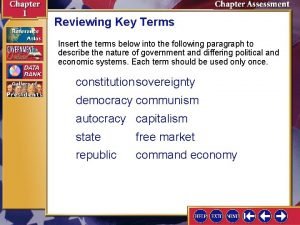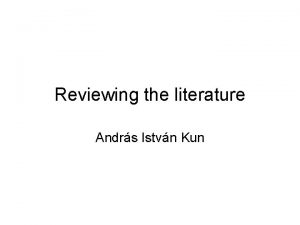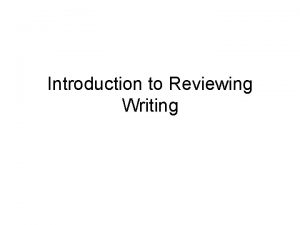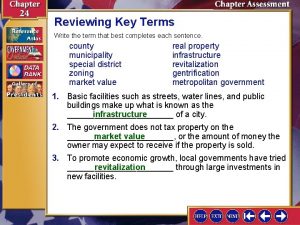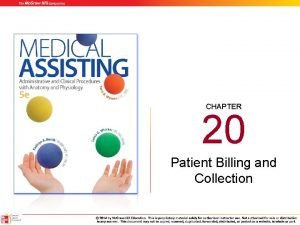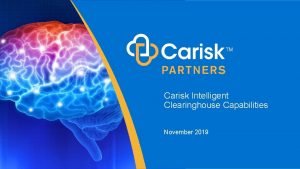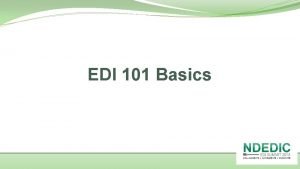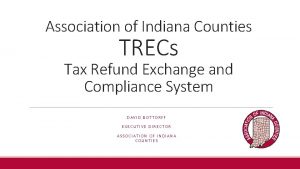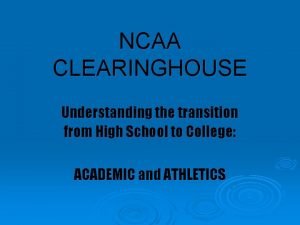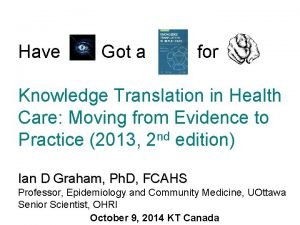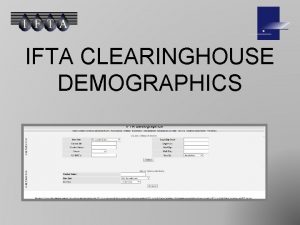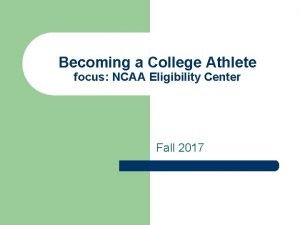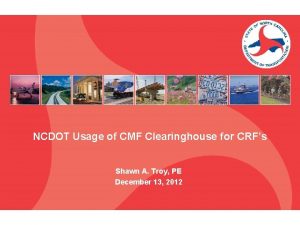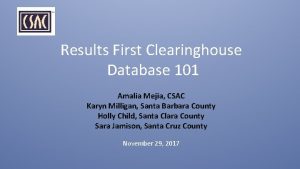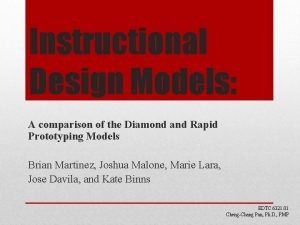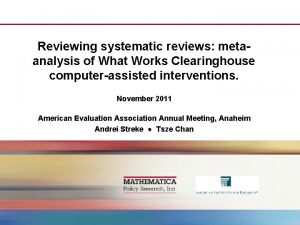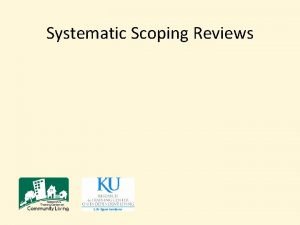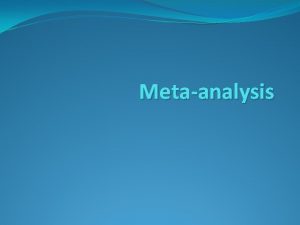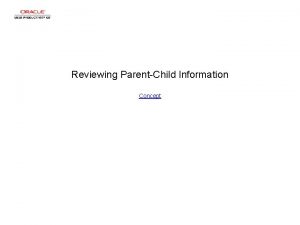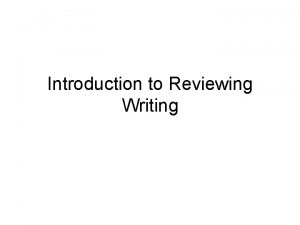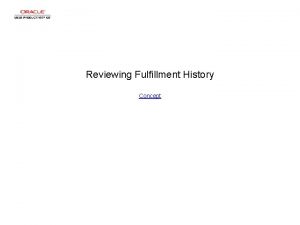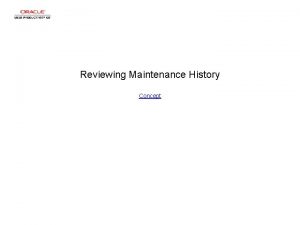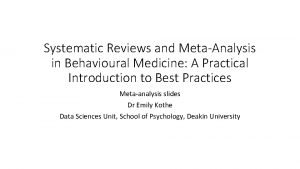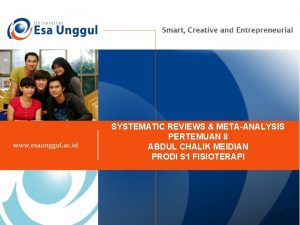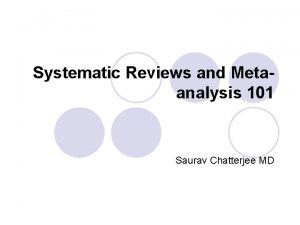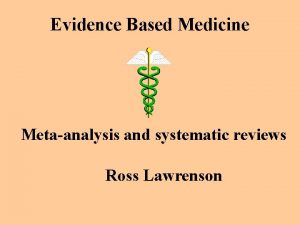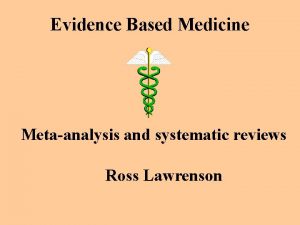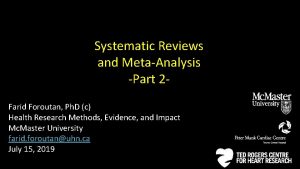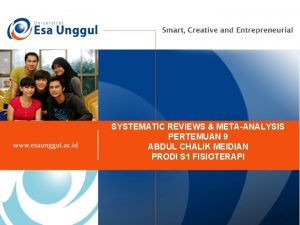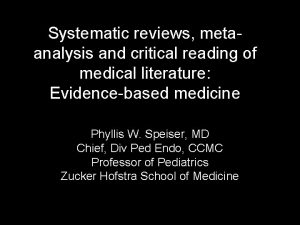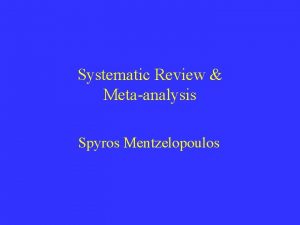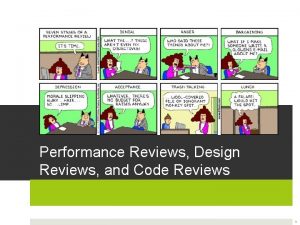Reviewing systematic reviews metaanalysis of What Works Clearinghouse












































- Slides: 44

Reviewing systematic reviews: meta-analysis of What Works Clearinghouse computer-assisted reading interventions. October 2012 Improving Education through Accountability and Evaluation: Lessons from Around the World Rome, Italy Andrei Streke ● Tsze Chan

Session 4. 2: Building and Interpreting Scientific Evidence Thursday, October 4 th 2

Presentation Overview § What Works Clearinghouse (WWC) systematic reviews § Meta-analysis of computer-assisted programs across WWC topic areas, reading outcomes § Meta-analysis of computer-assisted programs within Beginning Reading topic area (grades K 3) 3

Key terms What Works Clearinghouse (WWC) is a “central and trusted source of scientific evidence for what works in education. ” WWC produces systematic reviews on the effectiveness of educational interventions (programs, curricula, products, and practices) grouped by topic areas. Meta-analysis is a statistical technique that summarizes quantitative findings across similar studies. Each study’s findings are converted to a standard effect size. Computer-assisted interventions encompass reading software products, and programs that combine a mix of computer activities and traditional curriculum elements. 4

WWC Systematic Review § A clearly stated set of objectives with pre-defined eligibility criteria for studies § An explicit reproducible methodology § A systematic search that attempts to identify all studies that would meet the eligibility criteria § An assessment of the validity of the findings of the included studies § A systematic presentation, and synthesis, of the characteristics and findings of the studies 5

Meta-Analysis of Reading interventions § Extraction of statistical and descriptive information from intervention reports and study review guides § Aggregation of effect sizes across studies § Moderator Analysis -- ANOVA type -- Regression type 6

WWC Systematic Review WWC products: § Intervention reports http: //ies. ed. gov/ncee/wwc/publications_reviews. aspx § Practice guides § Quick reviews Normative documents (http: //ies. ed. gov/ncee/wwc ): § WWC Procedures and Standards Handbook § WWC topic area review protocol 7

8

Meta-analysis of computer-assisted programs across WWC topic areas, reading outcomes § Does the evidence in WWC reports indicate that computer-assisted programs increase student reading achievement? 9

Computer-assisted interventions 10

Example of computer-assisted programs § Earobics® is interactive software that provides students in pre-K through third grade with individual, systematic instruction in early literacy skills as students interact with animated characters. The program builds children’s skills in phonemic awareness, auditory processing, and phonics, as well as the cognitive and language skills required for comprehension. 11

Meta-Analysis procedures § Effect Sizes § Aggregation Method § Testing for Homogeneity § Fixed and Random Effects Models § Moderator Analysis -- ANOVA type -- Regression type 12

Effect Size (1) Effect size (Hedges & Olkin, 1985): 13

Flowchart for calculation of effect size (Tobler et al. , 2000) 14

Number of students and effect sizes by topic area Type of Program total intervention control Number of effect sizes Adolescent Literacy 26970 12717 14253 59 Beginning Reading 2636 1339 1297 151 Early Childhood Education 910 447 463 39 English Language Learners Total 308 173 135 6 30824 14676 16148 255 Number of students 15

Aggregation of Effect Sizes (1) Effect size (Hedges): (2) Effect size variance: Weight (w)= (Variance)-1 (3) Weighted average effect size: (4) Weighted average effect size variance: 16

Fixed and Random Effects Model weights § Fixed effects model weights each study by the inverse of the sampling variance. § Random effects model weights each study by the inverse of the sampling variance plus a constant that represents the variability across the population effects (Lipsey & Wilson, 2001). This is the random effects variance component. 17

Computer-assisted programs, random effects WWC Topic Area Adolescent literacy Beginning reading Early childhood education English language learners Number Weighted Lower Upper ZPof Effect Standard Confidence value Studies Size Error Interval 31 0. 13 0. 07 0. 18 4. 56 0. 00 33 0. 28 0. 06 0. 16 0. 40 4. 71 0. 00 6 0. 12 0. 07 -0. 01 0. 25 1. 74 0. 14 3 0. 30 0. 27 -0. 23 0. 83 1. 11 0. 38 18

Computer-assisted reading interventions, topic area effects and 95% CIs 1 0. 8 0. 6 0. 4 0. 2 0. 30 0. 28 0. 13 0. 12 0 -0. 2 -0. 4 Adolescent Literacy Beginning Reading 19 Early Childhood Education English Language Learners

Meta-analysis of computer-assisted programs within Beginning Reading topic area § Are computer-assisted reading programs more effective than non-computer reading programs in improving student reading achievement? 20

Selection Criteria for Beginning Reading Topic Area § Manuscript is written in English and published 1983 or later § Both published and unpublished reports are included § Eligible designs: RCT; QED with statistical controls for pretest and/or a comparison group matched on pretest; regression discontinuity; SCD § At least one relevant quantitative outcome measure § Manuscript focuses on beginning reading § Focus is on students ages 5 -8 and/or in grades K-3 § Primary language of instruction is English 21

Beginning Reading Topic Area 22

Example of “other” reading programs § Reading Recovery® is a short-term tutoring intervention intended to serve the lowest-achieving first-grade students. The goals of Reading Recovery® are to promote literacy skills, reduce the number of first-grade students who are struggling to read, and prevent long-term reading difficulties. Reading Recovery® supplements classroom teaching with one-to-one tutoring sessions, generally conducted as pull-out sessions during the school day. 23

Number of students and effect sizes by type of program: Beginning Reading topic area Type of Program Number of students Number total intervention control of effect sizes BR Computer-Assisted Programs 2636 1339 1297 151 Other BR Programs 7591 4042 3549 174 Total Beginning Reading 10227 5381 4846 325 24

Beginning Reading programs, random effects 95% M Standard Error Lower 95% PZ-value Upper value Type of Program n Computer-assisted programs 33 0. 28 0. 06 0. 16 0. 40 4. 71 0. 000 Other BR programs 47 0. 39 0. 04 0. 32 0. 47 9. 84 0. 000 Beginning Reading Total 80 0. 35 0. 03 0. 29 0. 42 10. 65 0. 000 25 Mathematica® is a registered trademark of Mathematica Policy Research.

Beginning Reading Interventions, Random Effects, 95% Confidence Intervals 1. 6 1. 4 1. 2 1 0. 8 0. 6 0. 4 0. 2 0 -0. 2 -0. 4 -0. 6 26

Moderator Analysis, random effects Modeling between study variability: § Categorical models (analogous to a one-way ANOVA) § Regression models (continuous variables and/or multiple variables with weighted multiple regression) 27

Categorical analysis: moderators of program effectiveness § Population § Design § Sample size § Control group § Reading domain 28

Weighted mean Effect Sizes for moderators: 80 studies, Beginning Reading, random effects 29

Weighted mean Effect Sizes for moderators: 80 studies, Beginning Reading, random effects 30

Dummy Variables for Regressions 31

Regression Statistics for BR Programs, Random effects 32

Regression Statistics for BR Programs, Random effects 95% M Standard Lower Error 95% PZ-value Upper value Type of Program n Computer-assisted programs 33 0. 28 0. 06 0. 16 0. 40 4. 71 0. 000 Other BR programs 47 0. 39 0. 04 0. 32 0. 47 9. 84 0. 000 Beginning Reading Total 80 0. 35 0. 03 0. 29 0. 42 10. 65 0. 000 33

Regression Statistics for BR Programs, Random Effects 34

Meta-Analytic Multiple Regression Results from the Wilson/Lipsey SPSS Macro 35

Conclusions § Investments in education have become an important national policy tool across the globe. With schools facing substantial costs of hardware and software, concerns naturally arise about the contribution of technology to students’ learning. § The present work lends some support to the proposition that computer-assisted interventions in reading are effective. The average effect for beginning reading computer-assisted programs is positive and substantively important (that is >0. 25). § For the Beginning Reading topic area (grades K-3), the effect appears smaller than the effect achieved by noncomputer reading programs. 36

References § Borenstein, M. , Hedges, L. V. , Higgins, J. P. , and Rothstein, H. R. (2009). Introduction to meta-analysis. John Wiley and Sons. § Hedges, L. V. and Olkin I. (1985). Statistical Methods for Meta-Analysis. New York: Academic Press. § Lipsey, M. W. , & Wilson, D. B. (2001). Practical meta-analysis. Thousand Oaks, CA: Sage. § Tobler, N. S. , Roona, M. R. , Ochshorn, P. , Marshall, D. G. , Streke, A. V. , & Stackpole, K. M. (2000). School-based adolescent drug prevention programs: 1998 meta-analysis. Journal of Primary Prevention, 20(4), 275 -336. 37

For More Information § Please contact: – Andrei Streke • AStreke@mathematica-mpr. com – Tsze Chan • TChan@air. org 38 Mathematica® is a registered trademark of Mathematica Policy Research.

39 Mathematica® is a registered trademark of Mathematica Policy Research.

Beginning Reading programs, random and fixed effects 95% M Standard Lower Error 95% PZ-value Upper value Type of Program n Computer-assisted programs 33 0. 28 0. 06 0. 16 0. 40 4. 71 0. 000 Other BR programs 47 0. 39 0. 04 0. 32 0. 47 9. 84 0. 000 Beginning Reading Total 80 0. 35 0. 03 0. 29 0. 42 10. 65 0. 000 Type of Program n M 33 0. 26 0. 04 0. 18 0. 34 6. 50 47 0. 34 0. 02 0. 29 0. 39 14. 35 0. 000 80 0. 32 0. 02 0. 28 0. 36 15. 65 0. 000 Computer-assisted programs Other BR programs Beginning Reading Total 95% Standard Lower Error 40 95% PZ-value Upper value 0. 000

Computer-assisted programs, random and fixed effects 41

Random versus Fixed Effects Models § Fixed effects model assume: (1) there is one true population effect that all studies are estimating (2) all of the variability between effect sizes is due to sampling error § Random effects model assume: (1) there are multiple (i. e. , a distribution) of population effects that the studies are estimating (2) variability between effect sizes is due to sampling error + variability in the population of effects (Lipsey and Wilson, 2001) 42

Beginning Reading Interventions, Random Effects, 95% Confidence Intervals 43

Examples of problematic study designs that do not meet WWC criteria § Designs that confound study condition and study site – Programs that were tested with only one treatment and one control classroom or school § Non-comparable groups – Study designs that compared struggling readers to average or good readers to test a program’s effectiveness 44
 What is metaanalysis
What is metaanalysis Comprehensive metaanalysis
Comprehensive metaanalysis Prospero systematic review
Prospero systematic review Nrswa revision
Nrswa revision Reviewing concepts and vocabulary chapter 1
Reviewing concepts and vocabulary chapter 1 Section 4 flatworms mollusks and annelids
Section 4 flatworms mollusks and annelids Preparatory empathy social work
Preparatory empathy social work Business communication chapter 6
Business communication chapter 6![] ]](data:image/svg+xml,%3Csvg%20xmlns=%22http://www.w3.org/2000/svg%22%20viewBox=%220%200%20200%20200%22%3E%3C/svg%3E) ]
] Reviewing key terms
Reviewing key terms Reviewing key concepts reproductive barriers
Reviewing key concepts reproductive barriers Reviewing the literature
Reviewing the literature Economic protest parties definition
Economic protest parties definition What is reviewing
What is reviewing Reviewing key terms
Reviewing key terms Chapter 20 patient collections and financial management
Chapter 20 patient collections and financial management Marzano reviewing content
Marzano reviewing content Ifta clearinghouse
Ifta clearinghouse Carisk intelligent clearinghouse
Carisk intelligent clearinghouse Tesia clearinghouse
Tesia clearinghouse Placed on hold by trecs local gov. clearinghouse.
Placed on hold by trecs local gov. clearinghouse. Clearinghouse cbus
Clearinghouse cbus Ncaa clearinghouse paperwork
Ncaa clearinghouse paperwork Clearinghouse student tracker
Clearinghouse student tracker Kt clearinghouse
Kt clearinghouse Vgin clearinghouse
Vgin clearinghouse Affordable housing clearinghouse
Affordable housing clearinghouse Care provider background screening clearinghouse
Care provider background screening clearinghouse Competency model clearinghouse
Competency model clearinghouse Fastener clearinghouse
Fastener clearinghouse Competency model clearinghouse
Competency model clearinghouse Noe r
Noe r Cmf clearing house
Cmf clearing house National student clearinghouse student tracker
National student clearinghouse student tracker Ncaa clearinghouse worksheet
Ncaa clearinghouse worksheet Fdp expanded clearinghouse
Fdp expanded clearinghouse Ifta clearinghouse
Ifta clearinghouse Background screening clearinghouse login
Background screening clearinghouse login Ncaa clearinghouse 2017
Ncaa clearinghouse 2017 Cmf troy
Cmf troy Results first clearinghouse database
Results first clearinghouse database Advantages and disadvantages of probing questions
Advantages and disadvantages of probing questions A systematic investigation
A systematic investigation Snowball sampling
Snowball sampling Instructional design models comparison
Instructional design models comparison
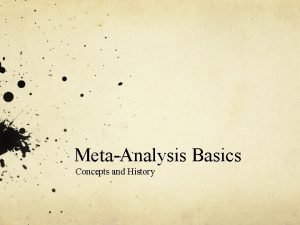
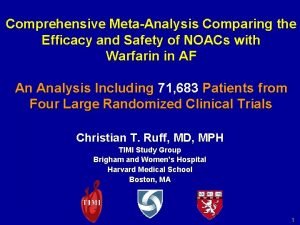
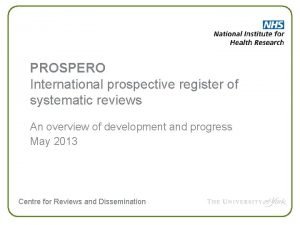



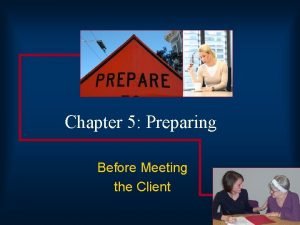
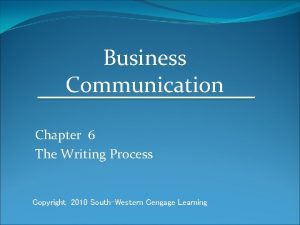
![] ]](https://slidetodoc.com/wp-content/uploads/2020/11/2404819_9eb8166b01395994bc3f851e1b2a9913-300x225.jpg)
